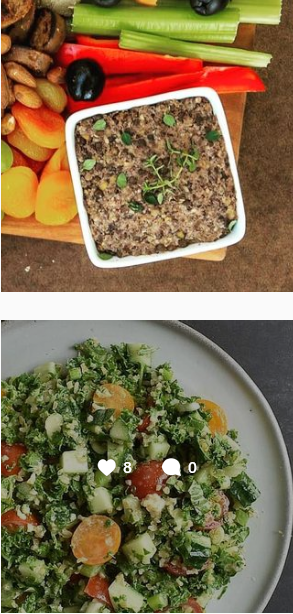Report Estimates the True Cost of Food in the US
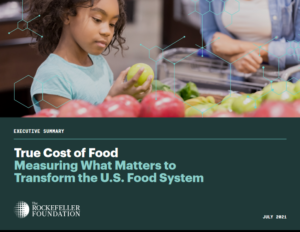
By Reed Mangels, PhD, RD
The Rockefeller Foundation recently published a report on the true cost of food in the US. This report is an attempt to measure the costs to our health, environment, and society of the current food production system. The report points out that in 2019, American consumers spent an estimated $1.1 trillion on food. Yes, that is trillion with 9 zeroes after the 1! That’s what we pay for labor, food production, processing, and transportation. Despite the enormity of this number, the report’s authors estimate that the true cost of food is at least three times higher – $3.2 billion per year.
The report provides the following estimates of “hidden” costs of the US food system:
- Human health $1.1 trillion per year – this includes direct health care costs and the cost of lost productivity due to diet-related diseases such as obesity, heart disease, cancer diabetes; the cost of workplace injuries and the effects of pollution due to food production on health
- Environment $350 billion per year – includes greenhouse gas emissions, water use, and soil erosion related to food production
- Biodiversity loss $455 billion per year – includes land use and pollution’s effect on biodiversity
- Livelihood $100 billion per year – includes the societal costs of child labor, unlivable wages, lack of benefits, and the cost of occupational safety and health
- Economy $21 billion per year – includes agricultural subsidies that are not accounted for in food prices
These costs are disproportionately borne by communities of color, as the report details.
A limitation of this report is that it did not assign a monetary value to animal suffering. The authors call for additional study of the true cost of animal food production in the US.
You may be wondering how the information in this report might be used. Possibilities include using this information to promote change in terms of fair wages, safer conditions for workers, subsidies and incentives for farmers and manufacturers, environmental regulations, and other food-related decisions that impact our health, the health of others, and the planet. Our food choices have costs and it is important to be aware of these and to work for systemic change.
Enjoy Mexican Soups and Stews
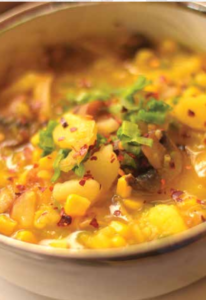
A previous issue of Vegetarian Journal features vegan Mexican recipes from Chef Carlos Erez. Chef Carlos was born and raised in New York City. His beautiful mother, a native of Mexico, taught him to cook. He’s been vegan over six years and loves translating her recipes and his heritage into compassionate new meals.
Recipes included in his article are: Mah Maiz! (a corn-based soup), Siete Mares (in Mexico, Caldo de Siete Mares is a classic seafood stew. In my vegan version, enjoy seven vegetables, including meaty oyster mushrooms, and a taste of the ocean from kelp powder!), Puebla Con Amor (Stuffed peppers in a rich broth), Señora Tortilla (a deeply authentic meal, originating in the state of Tlaxcala. His version finds its depth from toasted dry peppers and fresh tomatoes.), Mexican Rebel Veggie Stew, and El Rico (a hearty soup).
Find the entire article here: https://www.vrg.org/journal/vj2020issue1/2020_issue1_soup_stews.php
Subscribe to Vegetarian Journal in the USA only by visiting https://www.vrg.org/member/2013sv.php
World Vegan Day is November 1st Each Year
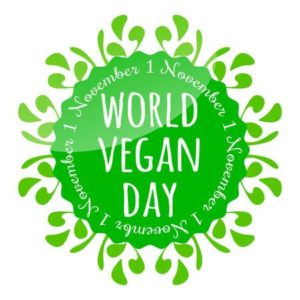
World Vegan Day is celebrated on November 1st each year! World Vegan Day first occurred on November 1st, 1994 as a way of commemorating the 50th anniversary of the United Kingdom Vegan Society and the term Vegan. Consider treating a non-veggie friend or co-worker to a delicious vegan meal today. This way you support vegan establishments while showing others how wonderful vegan food can be.
Visit The Vegetarian Resource Group online guide to veggie restaurants in the USA and Canada: https://www.vrg.org/restaurant/index.php
Spooky Vegan Halloween Dinner
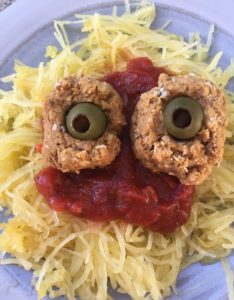
By Reed Mangels, PhD, RD
Imagine a pair of spooky eyes staring up at you from a plate of pale orange strands (or, could it be hair?), topped with red sauce. Then picture “bones” to dip into more red sauce (blood?) and you have the makings of a Halloween dinner.
Vegan Eye Balls (Adapted from Vive le Vegan! By Dreena Burton)
(makes 18 balls)
7 ounces firm or extra-firm tofu, torn or cut into pieces
1 Tablespoon cider vinegar
1 Tablespoon reduced sodium soy sauce
1½ Tablespoons catsup
1 teaspoon minced garlic (or to taste)
1 teaspoon oregano
1 Tablespoon nutritional yeast flakes
1 Tablespoon olive oil plus additional oil for baking sheet
Pepper to taste
1½ cups breadcrumbs
½ cup quick-cooking oats (uncooked)
18 pitted olives (pimiento stuffed olives are a nice touch, but black or green olives would also work)
Preheat oven to 375 degrees Line a baking sheet with parchment paper and drizzle on a little olive oil. In a food processor, purée tofu until smooth. Add remaining ingredients except breadcrumbs, oats and olives and process until smooth. Transfer mixture to a bowl and stir in breadcrumbs and oats. Let sit for 5 minutes to firm up. The mixture should hold together – add more breadcrumbs if necessary. Form mixture into balls about the size of a golf ball, carefully pressing an olive into each ball, and place on the baking sheet, olive facing up. Bake for 20-25 minutes until golden.
Spaghetti Squash
You can start baking this while you prepare the “eye balls.” Cut a spaghetti squash in half lengthwise and place cut-side down on a parchment-lined baking sheet. Bake at 375 degrees for 30-45 minutes, until squash is soft. Remove from oven and let cool enough to handle. Remove seeds. Use a fork to comb through the squash, separating the strands. Place the strands in a serving bowl.
Top the spaghetti squash (or you can use regular spaghetti) with pasta sauce (homemade or your favorite vegan brand) and then add a couple of “eye balls.”
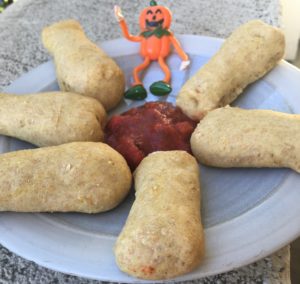
Breadstick “Bones” (Adapted from The Farm Vegetarian Cookbook, edited by Louise Hagler)
(makes 15 small breadsticks)
1 teaspoon vegan sugar
1 Tablespoon baking yeast
6 Tablespoons warm water
1 Tablespoon olive oil
1 cup all-purpose flour
½ cup wheat flour
½ teaspoon salt
2 Tablespoons nutritional yeast flakes
In a medium bowl, combine sugar and baking yeast and add warm water. Stir and let proof for 5 minutes. Add olive oil, all-purpose flour, wheat flour, salt, and nutritional yeast and stir, adding water or flour to make a smooth dough. Knead dough for 5 minutes. Form dough into relatively thin bones shapes (or just make thin breadsticks), place on a parchment paper-covered baking sheet, and let rise for an hour. Preheat oven to 400 degrees. Bake for 9 minutes or until done. Serve with a small bowl of pasta sauce for dipping.
Happy Halloween!
Vegan Apple Crumble
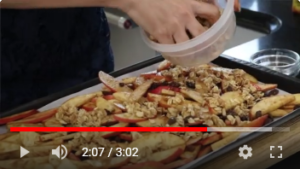
A perfect easy dessert or brunch dish to share! This simple recipe by Leslie Gray Streeter will come together in a snap and please any crowd. Toss together chopped apples (or pears) with seasonings and an oatmeal crumb topping. Everything goes on one sheet pan and into the oven. For a decadent treat, serve with a scoop of vegan vanilla ice cream!
Go to: https://youtu.be/WAQ6pPsqMnI
Vegan Restaurants Added to The Vegetarian Resource Group’s Guide to Veggie Restaurants in the USA and Canada

The Vegetarian Resource Group maintains an online Guide to Vegan/Vegetarian Restaurants in the USA and Canada. Here are some recent vegan restaurant additions. The entire guide can be found here: http://www.vrg.org/restaurant/index.php
To support the updating of this online restaurant guide, please donate at: www.vrg.org/donate
Here are some new additions to VRG’s guide (Note: Due to the COVID-19 pandemic many are doing take-out and/or delivery now):
Blondie’s Food Truck, 411 Pacific St., Honolulu, HI 96817
Situated in a Lowe’s parking lot, this food truck offers dishes such as a breakfast sandwich, veggie burgers, BBQ chik’n bowl, tacos, and more.
Freakin’ Vegan, 321 N. 8th St., Prospect Park, NJ 07508
Enjoy a wide variety of empanadas, mac n cheese dishes, subs/sliders, pizza, and desserts.
GreenPot, 86 Greenpoint Ave., Brooklyn, NY 11222
Owned by two sisters, GreenPot serves up a variety of coffee, pastries, vegan egg salad, sandwiches, and more.
Next Stop Vegan, 1818 Archer St., Bronx, NY 10460 and 1636 St. Nicholas Ave., New York, NY 10040
Enjoy sandwiches, wraps and bowls, and tostones with many veggie “meat” items at this Latina establishment. Some items are served in a fried plantain bowl!
Pure Vegan Café, 716 Slash Pine Dr., Cary, NC 27519 and 8369 Creedmoor Rd., Raleigh, NC 27613
Inspired by both a loved one’s illness and Ayurvedic principles, the café’s founder aims to bring healthy (and tasty) options to her community. Although probably best known for its fresh juices and acai bowls, Pure Vegan Café offers something for everyone. Both locations offer the extensive menu, complete with breakfast items such as gluten-free waffles and avocado toast; burgers and fries; chick’n sandwiches; and, of course, juices, shots & elixirs, smoothies, and acai bowls. There is even a kids’ menu. Whether you keep coming back for your favorite item or you want to sample all the offerings over time, Pure Vegan Café will likely become a regular stop on your restaurant rotation.
Sea Salt and Cinnamon, 100 S. Walnut St., Muncie, IN 47305
This vegan bakery offers both sweet and savory items. A variety of sweet items are available including macarons, cinnamon rolls, cupcakes, and pies. Classic flavors are available such as mint chocolate chip brownies and pumpkin pie, but the restaurant creates special dishes for any event. Custom cakes can also be designed for weddings, birthdays, and other events. In addition to their storefront, the restaurant sells items at farmer’s markets and partner locations.
Sharks Cove, 3612 SE 82nd Ave., Portland, OR 97266
Bringing tropical vibes from Hawaii, Sharks Cove food truck serves up education about shark conservation (especially on their Instagram @sharkscove_pdx) alongside a rich array of flavors. Options in their regular menu —all served with vibrantly colored flowers, mini-umbrellas etc. — include jackfruit nachos with tropical fruits and veggies; vegan coconut shrimp; beer battered fishless sandwiches; and, for dessert, island raspberry cheesecake made by local favorites Muse. They also have sample platters available and special weekend brunch menus. Many clearly marked gluten free options.
The Hardcore Hippie, Wilmington, NC (location varies)
Often found at local breweries and festivals, The Hardcore Hippie takes over the non-vegan NachoFalt’s truck once a week (carefully cleaning and using separate knives etc. to avoid cross-contamination), to serve up, healthy food at affordable prices. Constantly experimenting with their menu, check social media to see their latest creations. Options on a given day might include the likes of hummus and chickpea shawarma wraps; curries; Quinoa salad; or sandwiches with coconut bacon, arugula, tomato and garlic cashew cream.
Aquafabulous: Baking with Chickpea Liquid
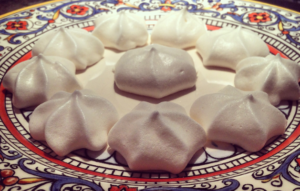
Perhaps you’ve heard about Aquafaba. The liquid you’ve been draining from your beans all these years is actually surprisingly similar to raw egg whites and can be used for baking in much the same way. The liquid can be baked, whipped to make meringue, turned into marshmallows, or used to create uncanny cheese substitutes.
Laura McGuiness shares her experience baking with aquafaba in a previous issue of Vegetarian Journal. She explains, “Aquafaba is still largely a mystery, even to scientists. The proteins and starches in the bean juice appear to mimic the proteins in egg whites, but the exact science leaves something to be desired. What we do know from an analysis by The Norwegian Food Research Institute is that aquafaba is mainly composed of starch and proteins. Because of the high starch content, aquafaba is able to form stable gels, which may aid in its ability to emulate egg whites.”
You’ll find the following recipes in this article along with photos of some
of the baked items:
Basic Meringue Cookies
Baked Alaska
Lemon Apocalypse Pie
Chocolate Mousse
Walnut Fudge
Lemon Dacquoise
The article can be found here: Aquafabulous
To subscribe to Vegetarian Journal, visit: http://www.vrg.org/member/2013sv.php
Join the Discussion with 545+ Families in The Vegetarian Resource Group’s Parents and Kids Facebook Group!

Recent topics brought up include:
– New Vegan Videos from The Vegetarian Resource Group
– Recipe shared for Banana Soft-Serve
– Vegan Children’s Books
https://www.facebook.com/groups/VRGparentsandkids is intended to be a
group that offers support for families raising children on vegan diets and for
vegan kids around the world. We envision it as a place to get advice about a
wide-variety of topics: pregnancy, birthday parties, school lunches, Halloween,
non-leather apparel, cruelty-free products, summer camps, and more. Please use
it as a place to share your wisdom, seek advice, or just find a sympathetic ear.
The goal is to offer support.
Consequently, any profane, defamatory, offensive,
or violent language will be removed. Feel free to disagree, but do so
respectfully. Hateful or discriminatory comments regarding race, ethnicity,
religion, gender, disability, sexual orientation, or political beliefs will not
be tolerated. We expect that posts should relate to vegan diets and lifestyles.
The Vegetarian Resource Group reserves the right to monitor all content and ban
any user who posts in violation of the above rules, any law or regulation,
SPAM, or anything otherwise off topic.
Please share this information with any veggie families that you know! Thanks.
What Does Added Sugar on a Food Label Mean?
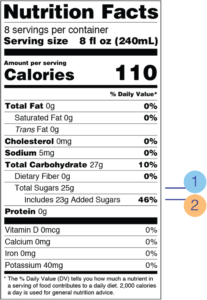
By Reed Mangels, PhD, RD
For many years, if you wanted to know how much sugar was added to a food, you could look at the ingredient list on the product’s label and look at the Nutrition Facts label which would tell you the total amount of sugar in the food. This was problematic for several reasons. Some food manufacturers would use lots of different sources of sugar in a product – for example, high fructose corn syrup, sugar, molasses, and brown sugar all might be listed as ingredients. Since ingredients are listed in descending order of how much of each is in a product, if there are lots of sources of sugar, none of them might make it to the top of the list of ingredients. You might think the product mainly contains peanuts but if you added up all the sugar sources, total sugar might really be the most prominent ingredient. Secondly, back when the label only listed total sugar, a product that had unsweetened dried fruit would look like it had lots of sugar when really, that sugar was there naturally in the form of fruit.
The new Nutrition Facts Label, required on all foods as of January 2021, tells the amount of added sugars that are in products. As the Food and Drug Administration says, “Added sugars include sugars that are added during the processing of foods (such as sucrose or dextrose), foods packaged as sweeteners (such as table sugar), sugars from syrups and honey, and sugars from concentrated fruit or vegetable juices. They do not include naturally occurring sugars that are found in [cow’s] milk, fruits, and vegetables.”
Recommendations call for limiting added sugar to 10% or less of total calories per day. That’s because these added sugars don’t much if anything for us nutritionally – they mainly supply calories. If you need 1600 calories a day, 160 calories or less should be from added sugar. Since sugars have 4 calories a gram, that means 40 grams or less of added sugar per day for someone who needs around 1600 calories a day. There is no requirement for added sugars; the 10% of calories is an upper limit.
I was recently looking at some popular vegan ice creams and noted that they had 30 grams or more of added sugar in a serving. Knowing which foods have a lot of added sugar and having a perspective on what is a reasonable amount of added sugar for you can help you choose foods and decide how much of these foods you want to eat.
